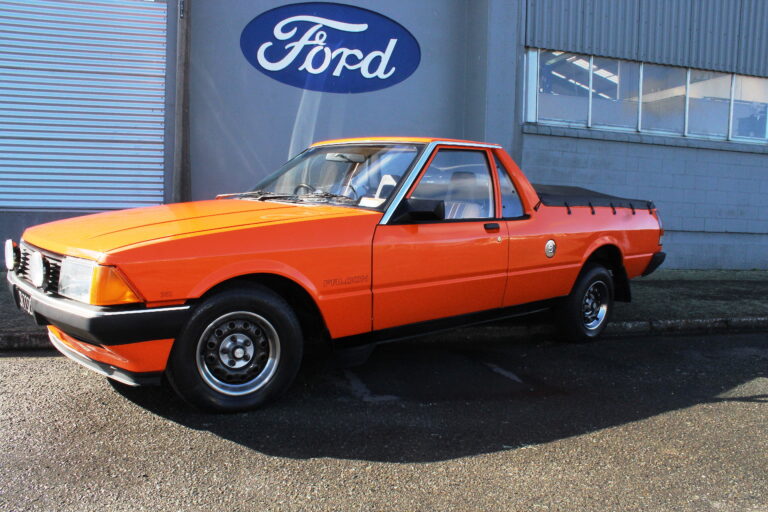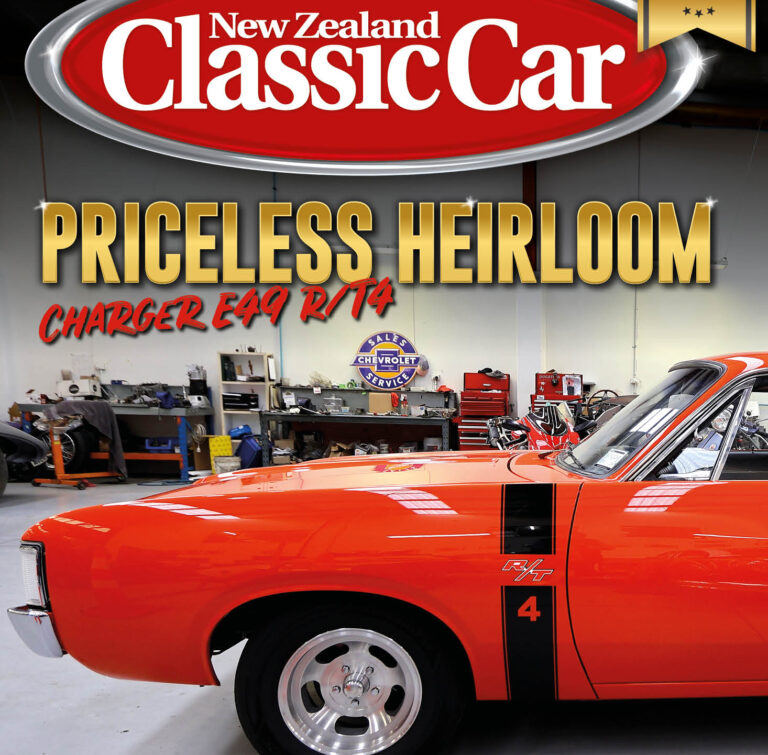data-animation-override>
“Published in New Zealand Classic Car Issue No. 214”

Alfa’s classic combination of an all-alloy V6 mated to a de Dion transaxle produced one of the best-handling coupes of the ’80s — Allan checks out a mint survivor
The first thing you notice when you climb aboard one of these ’80s Alfa coupes is the driving position — usually referred to as the ‘Italian ape’ position. If your body is normally proportioned, that means that if you move the driver’s seat too far backwards you’ll barely reach the steering wheel and will need to use the tips of your toes to operate the foot pedals.
Move the seat too far forward and, while you’ll be able to operate the foot pedals properly, the steering wheel will be in your chest. In the end, you accept a compromise and simply find a position that allows you to steer the car adequately without having your knees up around your ears.

It sounds awkward but, a few kilometres down the road you get used to it and, fortunately, the Alfa’s rack-and-pinion steering is light enough at speed to make up for the fact that you can’t quite get into the right position to apply manly leverage to the steering wheel.
However, everything gets a little heavier when it comes to slow speed manoeuvring and parking — you just have to put that down as an exercise in character-building.
Once on the move, though, you’ll quickly notice two disparate but closely linked elements — the sounds of Alfa’s all-alloy V6 and the quality of the gear-change. It was the latter that held itself up for my initial attention.
I once put a lot of kilometres under the belt of a GTV6, so getting reacquainted with our test car’s twin-plate clutch and five-speed gearbox was a little like meeting up with a long lost friend. And, even if I’ve changed over the intervening years, my friend hasn’t — the GTV6’s gear-change still feels odd and rubbery.
It’s not quite in the BMC ‘wooden-spoon-in-a-bowl-of-cold-porridge’ category but, after the first few changes, it certainly leans in that direction.
Fortunately, once I’d got more used to it, things brightened up markedly. It’s not that the GTV6’s gear-change lacks precision, it’s just the combination of floppy gear-lever and narrow gate which catches you out.
Some of this is undoubtedly down to the location of the actual gearbox which is, of course, mounted in unison with the car’s rear axle.
Playing tunes
It may seem less than ideal, but this is one gearbox that repays mastery as it is the driver’s vital link to the other, aforementioned element — the sound of the engine.
And, oddly enough, there’s even a bit of an enigma when you’re discussing Alfa’s 2.5-litre V6.
It was first introduced in the unloved Alfa Six saloon. Contemporary road-testers roundly slated both the car and its V6 engine, as its lack-lustre performance was not felt to conform to Alfa’s sporting traditions.

However, when Alfa Romeo elected to drop the same V6 into a revised Alfetta coupe body, everyone’s opinion changed and admiration for the 2.5-litre V6 was widely expressed. So, how did Alfa effect this volte-face?
A lot was down to the liberating affect of simply shedding weight — the Alfa Six weighed in at 1470kg, 260kg more than the GTV6 — but much was also due to the addition of Bosch L-Jetronic fuel injection and, for its day, a relatively sophisticated engine management system. By comparison, the Alfa Six had sucked petrol through a battery of six Dell’orto carburettors — a system that proved fickle and unreliable. Alfa Romeo was on the cusp of a more modern motoring age and, shorn of the Alfa Six’s accoutrements, the V6 was allowed to shine.
Make no bones about it, this aluminium beauty really sings in the GTV6 and is, without doubt, the heart and soul of this car. That, of course, is why mastering the GTV6’s gear-change is such a important factor. Get it wrong and you’ll only get the consolation prize of gnashing gear-teeth. If mastery eludes you, it is possible to employ the ample supply of torque from the V6 to cut down on cog-swapping — but then you’ll miss out on the full reward of hearing one of the best sounding engines ever produced. Essentially, you’re the conductor, the gear-lever is your baton and that lovely V6 is the symphony orchestra. Time it all properly and you can play some wonderful tunes.
If that all seems a little far-fetched, here’s a line from a letter that famed conductor and self-confessed car enthusiast, Herbert von Karajan, once wrote to Enzo Ferrari — “When I hear your 12 cylinders, I hear a burst of harmony no conductor could ever recreate.” He could just have easily been talking about Alfa’s V6.
Dancing in time to the music
Sounds apart, the GTV6 also offers a very appetising bonus — beautifully precise handling. A lot of this sense of innate balance comes from Alfa’s decision to go with a transaxle, which gave the car a 50/50 weight distribution — it even went for inboard rear brakes to keep unsprung weight to a minimum. With a race-bred combination of a de Dion rear axle, longitudinal torsion bars and responsive, pin sharp steering, the GTV6 feels like a true sports car on the road — literally allowing you to dance in time with the music from the car’s V6.
Press on and you soon discover that the GTV6’s handling tends towards gentle and very predictable understeer, with the rear end showing no signs of sudden breakaway even under hard cornering. When provoked, the tail will step out, but the movement is telegraphed straight to the driver, allowing any errant behaviour to be easily caught.
Our test car, fitted with a recently reconditioned hail and very hearty V6, was even more firmly planted on the road courtesy of some fancy dancing shoes — a set of locally produced, super light three-piece alloy wheels — 16 by seven-inch up front and 16 by eight-inch at the rear (check out our side-bar on 41° Racing Wheels for more information.)

With these bespoke rims wrapped in modern, low profile directional rubber — 225/45 and 245/45 — loads of grip is available and, as an extra, the new wheel and tyre combination gives the Alfa an added air of aggression.
All I could think of to criticise was that the GTV6’s standard, rather high ride height made it feel as if it were standing on tip-toes. Not a real problem, other than cosmetically, but it did mean the car displayed a tendency to float a little over high speed road undulations.
On this particular car, that tendency will soon be tamed as a set of Shankle springs and uprated sway bars — together with a lowered ride height — are to be added to the overall formula. These final modifications should give the GTV6 even more precision. You really couldn’t ask for more in a sporting coupe, and our test car is a real time capsule. Sold new by Continental Car Services, this GTV6 — surprisingly for a car of this type — has only ever had two registered owners. All servicing on the car has been handled by Continental throughout its life, and accompanying service records show this Alfa has only covered 115,000 kilometres — regular servicing and low mileage, for its age, goes some way to explaining why this particular GTV6 drives so tautly.
In addition to the wheel and suspension alterations, the exterior and interior of the GTV6 has also been tidied up considerably, including cosmetic repairs to both front and
rear bumpers.
Changing times
But I digress; back to the birth of the GTV6. By the mid ’70s, Alfa’s venerable 105 series GTV was showing its age and a more modern replacement was required. Giugiaro’s styling of the 105 GTV had been such a success that it was natural for Alfa Romeo to go back to Bertone, where Giugiaro was still working, for the replacement. In what would become one of his final projects for Bertone, Giugiaro penned a very stylish coupe on a shortened Alfetta saloon floor pan.
Released in 1974 as the Alfetta GTV, the new Alfa would eventually become available with either 1.6-litre, 1.8-litre or 2.0-litre twin-cam engines.
Taking into consideration modern conditions and demands, the new Alfetta was surprisingly roomy inside — easily the most spacious coupe ever to come from Alfa Romeo at that time.
However, the biggest change came in 1981 when Alfa dropped the Alfa Six’s 2.5-litre V6 into the car to produce the GTV6 — now in fuel-injected form rather than carburetted as in the Alfa Six (the Alfa Six would eventually also gain fuel injection.)
In order to clear the intake on the V6, the bonnet of the GTV6 received a bulge — apart from the badging, this is the most noticeable difference between the Alfetta GTV and the GTV6. The new GTV6 drew instant praise from the motoring press, and enthusiasm for the worth of the car was proved on the race circuit when the GTV6 won the European Touring Car Championship an amazing four times in succession from 1982 to 1985. In the capable hands of Andy Rouse, a GTV6 also claimed the 1983 British Touring Car Championship.
GTV6 Specials
To a certain extent, the popularity of the GTV6 was also demonstrated by the number of special versions that became available. In South Africa, where Alfa Romeos were assembled alongside Datsuns in Pretoria, a turbocharged GTV6 was produced. Around 750 cars ere fitted with a single Garrett turbocharger, fed through a NACA duct. Interestingly, the South African market would also produce a 3.0-litre GTV6 well before Alfa Romeo introduced a V6 of that capacity for the European market, although never for the GTV6. About 200 of these special GTV6s were manufactured to homologate the car for racing. Over in the US, the GTV6 also quickly gained popularity, and the car went through several limited edition models, including now sought after models such as the GTV6 Balocco and Maratona. Even Callaway Cars — now famed for its go-faster, bespoke Corvettes — tried its hand at modifying the GTV6, building around 30 Calloway versions complete with twin turbochargers, revised suspension and big brakes. A twin-turbo GTV6 was also available for a short time in Australia.
The music master
We’ll leave the final word on the GTV6 to Alfa Romeo itself. Its publicity department penned these words back in the ’80s.
“From the first time you take the wheel of the GTV6 you will understand what performance driving is all about. With the superior levels of power and control, and a perfect balance of both, the GTV6 redefines driving as an art. An art that we have learned from over 100 Grand Prix victories.”
On the strength of an afternoon’s drive in our featured GTV6, I’d say that for once, the PR spin doctors got it right!
1985 Alfa Romeo GTV6 – Specifications
Engine: All-alloy V6
Capacity: 2492cc
Bore/stroke: 88 x 68.30mm
Comp ratio: 9.00:1
Valves: sohc per bank
Max power: 119kW (160bhp) at 6000rpm
Max torque: 213Nm at 4000rpm (coupe)
Fuel system: Bosch L-Jetronic fuel injection
Transmission: Five-speed manual
Suspension (F/R): F: independent, torsion bars R: de Dion, coil springs
Steering: Rack and pinion
Brakes: Disc/disc
Dimensions
Wheelbase: 2400mm
O/all length: 4260mm
Width: 1664mm
Height: 1330mm
Track F/R: 1352mm
Weight: 1210kg
Performance
Top Speed: 212kph (132mph)
0-60mph: 8.8 seconds
Standing ¼: 16.7 seconds
Avg fuel consumption: 10.08l/100km (28mpg)
Production: 22,381*
(* Source: Alfa Romeo Production Cars by Stefano d’Amico)
Words: Allan Walton Photos: Adam Croy


